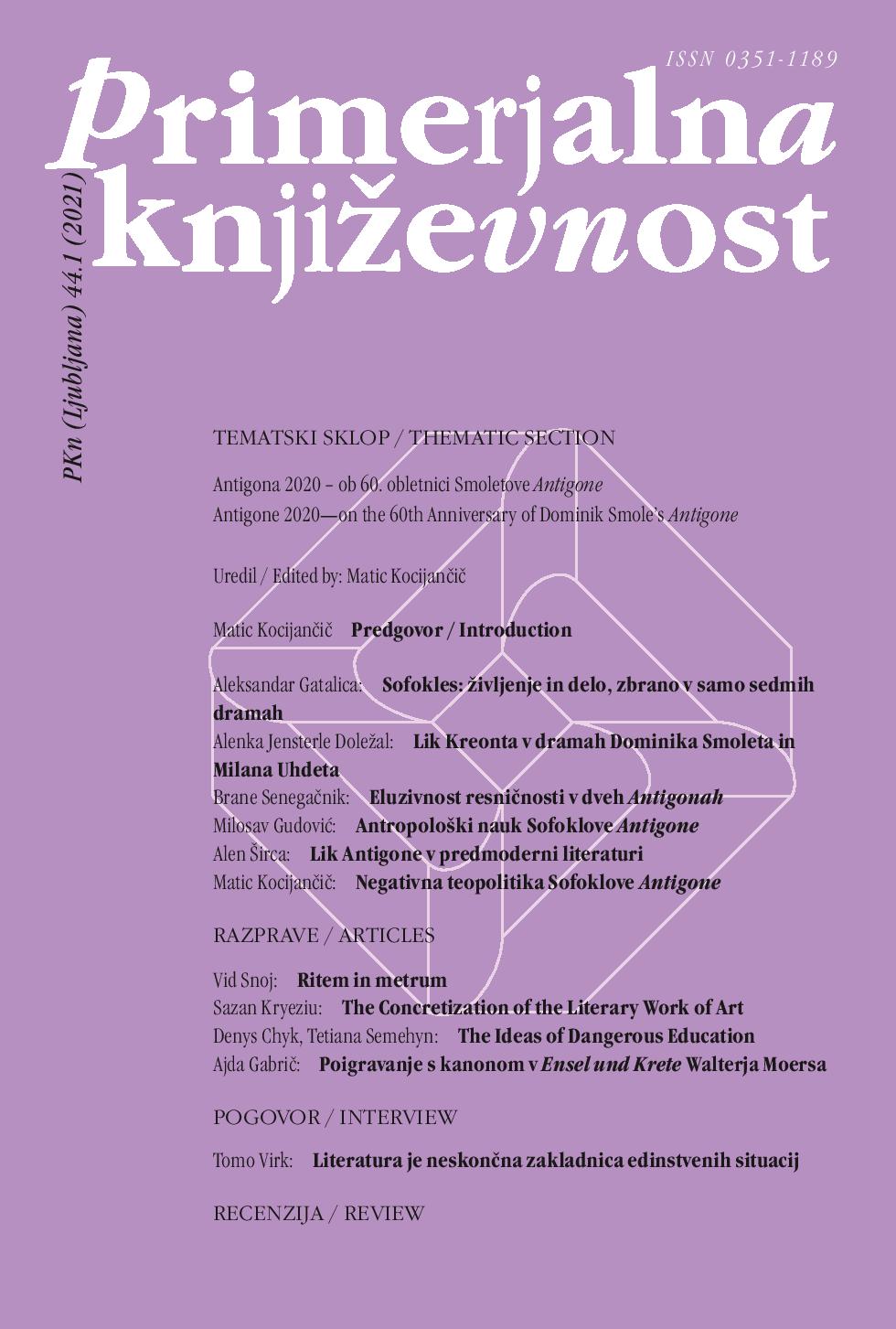Playing with Canon in Walter Moers’s Ensel und Krete
DOI:
https://doi.org/10.3986/pkn.v44.i1.10Keywords:
German literature, fairy tale, Moers, Walter: Ensel und Krete, literary canon, intertextuality, allusion, parodyAbstract
The German writer Walter Moers uses two main ways to play with literary canon in his work Ensel und Krete: on the one hand, by intertextually referring to older texts, and on the other, by ironically parodying the image of the canonised poet as an important person. The paper uses Genette’s theory of intertextuality to analyse the intertextual relationships that define the novel, identifying the main works that the text refers to. The source for Ensel und Krete is the fairy tale Hänsel und Gretel by Grimm brothers. However, it serves only as the source for the main plot, which is then transformed in order to self-referentially play with literary conventions as well as to quote and allude to other works of German and world literature. The other main element of playing with the literary canon is playing with the image of the artist. To analyse the latter, the paper uses the model of canonisation advocated by Dović in order to outline the representation of the fictional author of the novel, who presents an ironic reflection of the classical poet. The classical poet is supposed to convey aesthetic values to his readers through his text and represent the basis for a cult which brings together a community. In Moers’s text, however, the fictional author is presented as an arrogant, conceited person, and his cultural activity is represented as banal. The intertextual references as well as the play with the writer’s image are the basis for the ironic humour that permeates the text.
References
Bauer, Manuel. »Wie wird aus einem Grimm’schen <em>Kinder- und Hausmärchen</em> ein Kunstmärchen aus Zamonien? Walter Moers’ <em>Ensel und Krete</em> und die Transformation eines romantischen Märchenmodells«. <em>Märchen, Mythen und Moderne. 200 Jahre Kinder- und Hausmärchen der Brüder Grimm. Teil 1</em>. Ur. Claudia Brinker-von der Heyde et al. Frankfurt am Main: Peter Lang, 2015. 403–412.
Berndt, Frauke, in Lily Tonger-Erk. <em>Intertextualität. Eine Einführung</em>. Berlin: Erich Schmidt Verlag, 2013.
Dović, Marijan. »Model kanonizacije evropskih kulturnih svetnikov«. <em>Primerjalna književnost</em> 35.3 (2012): 71–85.
Dović, Marijan. »Sodobni pogledi na literarni kanon in njegovo družbeno vlogo«. <em>Dialogi</em> 39.1–2 (2003): 18–44.
Friedrich, Hans-Edwin. »Was ist ein Märchen aus Zamonien? Zu <em>Ensel und Krete</em> von Walter Moers«. <em>Walter Moers’ Zamonien-Romane. Vermessungen eines fiktionalen Kontinents</em>. Ur. Gerrit Lembke. Göttingen: V&R unipress, 2011. 193–213.
Genette, Gérard. <em>Palimpseste. Die Literatur auf zweiter Stufe</em>. Prevedla Wolfram Bayer in Dieter Hornig. Frankfurt am Main: Suhrkamp, 1993.
Goljevšček, Alenka. <em>Pravljice, kaj ste?</em> Ljubljana: Mladinska knjiga, 1991.
Grimm, Brüder (Jacob und Wilhelm). <em>Kinder- und Hausmärchen. Ausgabe letzter Hand</em>. Ur. Heinz Rölleke. Stuttgart: Philipp Reclam, 2009.
Juvan, Marko. »Interesi parodij, literarni kanon in razvoj«. <em>Slavistična revija</em> 42.1 (1994): 81–109.
Juvan, Marko. <em>Intertekstualnost</em>. Ljubljana: DZS, 2000.
Juvan, Marko. »Literarni kanon«. <em>Literatura</em> 3.3–4 (1991): 116–135.
Kos, Janko. <em>Literarna teorija</em>. Ljubljana: DZS, 2001.
Lembke, Gerrit. »‘Der Große Ompel’. Kartographie und Topographie in den Romanen Walter Moers’«. <em>Walter Moers’ Zamonien-Romane. Vermessungen eines fiktionalen Kontinents</em>. Ur. Gerrit Lembke. Göttingen: V&R unipress, 2011. 87–119.
Lembke, Gerrit. »‘Hier fängt die Geschichte an.’ Moers’ Zamonien-Romane. Vermessungen eines fiktionalen Kontinents«. <em>Walter Moers’ Zamonien-Romane. Vermessungen eines fiktionalen Kontinents</em>. Ur. Gerrit Lembke. Göttingen: V&R unipress, 2011. 15–41.
Lüthi, Max. <em>Evropska pravljica. Forma in narava</em>. Prevedla Alenka Veber. Ljubljana: Sophia, 2011.
Lüthi, Max. <em>Märchen. 10., bearbeitete Auflage</em>. Ur. Heinz Rölleke. Stuttgart, Weimar: Verlag J. B. Metzler, 2004.
Moers, Walter. <em>13 1/2 življenj kapitana Sinjedlakca</em>. Prevedel Darko Dolinar. Ljubljana: Cankarjeva založba, 2000.
Moers, Walter. <em>Ensel und Krete</em>. Frankfurt: Goldmann, 2002.
Moers, Walter. <em>Mesto sanjajočih knjig</em>. Prevedla Stana Anželj. Ljubljana: Sanje, 2010.
Rilke, Rainer Maria. <em>Rainer Maria Rilke</em>. Izbral in prevedel Kajetan Kovič. Ljubljana: Mladinska knjiga, 1998.
Thiem, Ninon Franziska. »Auf Abwegen. Von (para-)textuellen Abschweifungen in Walter Moers’ <em>Ensel und Krete</em>«. <em>Walter Moers’ Zamonien-Romane. Vermessungen eines fiktionalen Kontinents</em>. Ur. Gerrit Lembke. Göttingen: V&R unipress, 2011. 215–232.
Zupan Sosič, Alojzija. <em>Teorija pripovedi</em>. Maribor: Litera, 2017.


